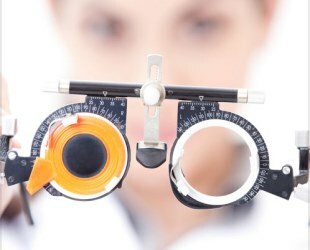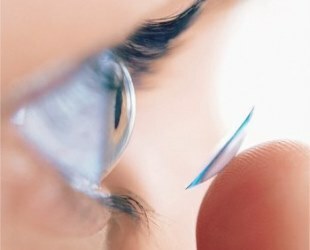
Contact lenses are a widely used method of vision correction, which can be used for astigmatism, nearsightedness and farsightedness. Using the latest technology and materials allows you to call contact lenses a worthy alternative to points.
In case of correct selection of lenses - taking into account the material from which they are made, the radius of curvature and the optical power - they enable to get sharp eyesight in comfortable use.
- 1. Types of contact lenses and how long they should be worn
- 2. The correct choice of contact lenses
- 3. Which contact lenses should I prefer
- 4. Using contact lenses and proper care for them
Contact lenses give a higher quality of vision, rather than glasses, since the lenses form a single system with the eye, and in this system there is no dependence on weather conditions( snow, rain) and the limitation of the field of view.
Contact lenses are a real treat when glasses are unacceptable or inconvenient, as in the case of athletes, divers or race drivers.
They are also indispensable for patients with a significant difference in visual acuity of the right and left eyes. Today, lenses are produced in a wide optical range, they produce lenses to compensate for astigmatism( toric), multifocal and aspherical, colored lenses of various shades.Types of contact lenses and how long they are worn
Contact lenses manufactured to date are classified according to the following characteristics:
- By the time of routine lens replacement:
- traditional( their service life is from 6 to 9 months);
- quarterly;
- monthly;
- two-week;
- one-day.
- prolonged - can be used from 1 to 7 days;
- fluorescent - can be worn for 7-10 hours, before going to bed they need to be removed.
- rigid;
- soft.
- spherical - include most of the traditional lens models;
- aspherical - have improved optical characteristics;
- multifocal - with several zones having different optical power, are used to correct presbyopia;
- toric - used to correct astigmatism;
- therapeutic - designed to temporarily protect the cornea of the eye after surgery;
- orthokeratology - lenses worn at the time of sleep with a view to temporarily improving visual acuity during the day;
- colored contact lenses;
- carnival contact lenses.
The right choice of contact lenses

Everyone who thinks about switching to contact correction of vision should remember that the choice of lenses can only be dealt with by an ophthalmologist in a specialized office of contact correction.
Amateur activities can lead to harmful effects in the form of a variety of complications - inflammatory diseases, hypoxic changes in the cornea, dry eye syndrome.
Even among patients who use contact lenses for a fairly long time, it is very common misconception that the transition to a new model requires only checking the eyes and finding out parameters such as the radius and diameter of the lens, as well as its optical power.
Let's consider in more detail which properties do not allow you to choose your own contact lenses.
There is the concept of an "individual eye shape", defined not only by the radius and diameter of the lens, but also by many other parameters that are often not indicated on the packages. Such characteristics include, for example, the method of processing the edge of the lens, the elasticity of the material and its other properties. In the production of contact lenses of polymers with different properties, each company uses its technological methods.
Therefore, the final form of lenses having the same radius and diameter can also vary greatly. In addition, sometimes patients may experience allergic reactions to the material from which the lenses are made. Therefore, even having decided to replace one type of lens with another, it is necessary to undergo a thorough examination from an ophthalmologist. Read more - what to do with eyelid edema? Diagnosis and treatment methods.
The article( here) instructions for the application of Lucentis.
Instructions for use and price for Tropicamide!http: //moezrenie.com/lechenie/ kapli-dlya-glaz / vse-o-tropikamid.html
It should be noted that the very test of vision itself is not capable of taking into account all the problems that can arise in connection with the wearing of contact lenses. It is precisely their selection that is required, which includes the choice of model and optical power, the evaluation of the fitting of the lens to the eye, and the quality of vision when using new lenses.
The procedure for choosing lenses should begin with the patient's conversation with the doctor, during which the goals of using contact lenses, patient's motivation, identification of concomitant diseases and possible contraindications, bad habits, work features are determined, because all these factors can further affect the degree of comfort when wornlenses.
Only after that the ophthalmologist should appoint a complex ophthalmological examination of the eyes, which includes:
- biomicroscopy - an assessment of the condition of the anterior segment of the eye;
- autorefractometry;
- definition of the level of visual acuity;
- examination of the fundus allowing to exclude organic pathologies affecting the quality of vision;
- keratometry.

When choosing contact lenses, the physician should also take into account the characteristic features of the eye structure of the patient: the incision of the eyelids and their density, the number and composition of the tear, the peculiarities of the vascular bed.
After determining the required optical power and ending with the choice of the model, the ophthalmologist should evaluate her landing on the cornea using special tests, after which it is necessary to check the residual refraction and visual acuity of the patient in the lenses.
No less important step in the selection of contact lenses is training the patient to wear and remove lenses on their own. In addition, the doctor must give advice on the care of lenses, usually done in writing. At the end of the session, the next visit must necessarily be assigned, on which the local reaction of the eyes to the lenses is evaluated, and the tolerability of the contact correction in general.
Only proper selection of lenses and following all instructions of the doctor will avoid possible complications and get functional and cosmetic advantages.
Which contact lenses should I prefer
? As for the question, which lenses are better, we will consider in more detail the most common ones.

Most often doctors prescribe to patients soft contact lenses, which are made of special polymeric materials - silicone hydrogel or hydrogel. The most comfortable in use - one-day lenses, the wearing time of which is from 7 to 10 hours.
One-day lenses are the thinnest and contain a lot of water, but their disadvantage is a very high cost.
For the appointment of hard contact lenses, there are indications, including keratoconus and pronounced astigmatism. This type of lens has the highest oxygen capacity.
Most color lenses are designed for people with visual acuity of at least -6 diopters. It should be noted that color contact lenses, especially prolonged wearing, are not suitable for everyone, since the use of such lenses suggests a higher probability of allergic reactions than the wearing of traditional lenses.
For people who have a dark eye color, most of the color lenses offered today are not suitable for changing the color of the iris, since they are, in fact, tinted.
The use of contact lenses and proper care for them
The durability of contact lenses, as well as the maintenance of eye health, largely depends on the thorough care of the lenses. Modern models are easy to care and use. Therefore, there is no need to worry about the complexity of care for them - modern disinfectant solutions give the opportunity to minimize these efforts.
Most of the disinfectants for the care of contact lenses are multi-purpose solutions, that is, it simultaneously performs the functions of cleaning, disinfection, moistening, and can also be used to store lenses. But if you treat those who are afraid of the need for daily care of contact lenses, you should give preference to one-day soft contact lenses.

Note - treatment of blepharospasm. How to prescribe a treatment?
In the news( in more detail) the cause of bruises under the eyes of women.
Reviews of the gel eye Solcoseryl!http: //moezrenie.com/lechenie/ glaznye-mazi / gel-solkoseril.html
To prevent the occurrence of big troubles, in case of even the slightest symptoms of discomfort caused by the use of contact lenses, you should for a while refuse to wear them and visit a doctor as soon as possible. And since some complications arising from the use of lenses can initially proceed without any significant symptoms, do not forget about the examinations of the ophthalmologist, which should be carried out at least 1-2 times a year.
